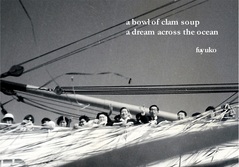Tanka
The Japanese tanka is a short lyric, consisting of five parts with 5, 7, 5, 7 and 7 syllables in a row, thus producing a special rhythm. Traditionally, tanka are written in Japanese in one single, unbroken line.
Western tanka also have this 5-7-5-7-7-syllable form, but divided over five lines. This raises difficulties in translating tanka from Japanese into English. Besides, Japanese words consist of moras (usually one consonant + vowel) and usually have more syllables than words in Western languages. For example: “my dream” (2 syllables) is “watashi no yume” (6 syllables) in modern Japanese, and “wa ga yume” (4 syllables) in classic Japanese. In short, 31 syllables in Japanese will contain fewer words than 31 syllables in English. The Japanese 5-7-5-7-7-standard will be around 3-5-3-5-5 in English. Translators sometimes add words in order to make the number of syllables right, which – unfortunately - often kills the charm and simplicity of the original.
Amy V. Heinrich translated the tanka of Mokichi Saito. Her view on translating tanka is most valuable. She wrote:
Western tanka also have this 5-7-5-7-7-syllable form, but divided over five lines. This raises difficulties in translating tanka from Japanese into English. Besides, Japanese words consist of moras (usually one consonant + vowel) and usually have more syllables than words in Western languages. For example: “my dream” (2 syllables) is “watashi no yume” (6 syllables) in modern Japanese, and “wa ga yume” (4 syllables) in classic Japanese. In short, 31 syllables in Japanese will contain fewer words than 31 syllables in English. The Japanese 5-7-5-7-7-standard will be around 3-5-3-5-5 in English. Translators sometimes add words in order to make the number of syllables right, which – unfortunately - often kills the charm and simplicity of the original.
Amy V. Heinrich translated the tanka of Mokichi Saito. Her view on translating tanka is most valuable. She wrote:
’There are two essential points to consider in translating tanka into English. The first is that the primary goal of the translator is to make a poem in English – one that is compelling enough to stand on its own. This is, of course, an ideal none of us reach all the time. The second is that to communicate what is particular to the tanka form one must create a poem in English that retains the feeling of distillation that is in the best tanka – the sense that only what is essential to communicating an experience is included: the reader is required to provide the rest. Therefore, I think it is important not to expand words of the translation to include what the reader understands of the poet’s meaning, but instead to limit oneself to the actual constructions the poet used. …..’ (THE TANKA JOURNAL 1999 no.14, Nihon Kajin Club)
I decided to translate my own tanka into English, completely free of syllable counting, the five-line rule or a particular word order. My translations are not meant to be literal. I have tried to give my English translations the same ‘heartbeat’ and rhythm of my original, Japanese tanka: a privilege only the author can have.
人は皆己を映す鏡なり皆去りゆくよと笑みし女はも
Hito wa mina/onore o utsusu/ kagami nari/mina sariyukuyo to/emishi hito wamo
Hito wa mina/onore o utsusu/ kagami nari/mina sariyukuyo to/emishi hito wamo
帳下ろし心に灯す雪明かり雪の原野に誰が足跡ぞ
Tobari oroshi/ kokoro ni tomosu/ yuki-akari/ yuki no genya ni/ da ga ashiato zo
Tobari oroshi/ kokoro ni tomosu/ yuki-akari/ yuki no genya ni/ da ga ashiato zo
我が敵は砂漠の地平に現わるる絶望という蜃気楼なり
Waga teki wa/ sabaku no chihei ni/ arawaruru/ zetsuboo to iu/ shinkiroo nari
Waga teki wa/ sabaku no chihei ni/ arawaruru/ zetsuboo to iu/ shinkiroo nari
国を出でし時止まってしまった我が時計巻いても巻いても二十二歳
Kuni o ideshi toki/ tomatte shimatta/ waga tokei/ maitemo maitemo/ nijuuni-sai
Kuni o ideshi toki/ tomatte shimatta/ waga tokei/ maitemo maitemo/ nijuuni-sai
さんさんとそそぐ朝日の文机に遺す未完の歌ぞ淋しき
Sansan to/ sosogu asahi no/fuzukue ni/ nokosu mikan no/ uta zo samishiki
Sansan to/ sosogu asahi no/fuzukue ni/ nokosu mikan no/ uta zo samishiki
我老いて開ける格子戸ただいまと呼べど叫べど答えなき夢
Ware oite/ akeru koushido/ tadaima to/ yobedo sakebedo/ kotae naki yume
Ware oite/ akeru koushido/ tadaima to/ yobedo sakebedo/ kotae naki yume





